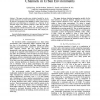Free Online Productivity Tools
i2Speak
i2Symbol
i2OCR
iTex2Img
iWeb2Print
iWeb2Shot
i2Type
iPdf2Split
iPdf2Merge
i2Bopomofo
i2Arabic
i2Style
i2Image
i2PDF
iLatex2Rtf
Sci2ools
150
click to vote
VTC
2006
IEEE
2006
IEEE
Path Loss Models for Air-to-Ground Radio Channels in Urban Environments
Abstract—This paper provides new statistical models for air-toground channels in an urban environment. The model is derived to operate at frequencies from 200MHz to 5GHz. Issues such as path loss and shadowing are evaluated as a function of the elevation angle to the airborne platform, rather than the more usual separation distance used for terrestrial mobile communications. Results demonstrate the advantages of an airto-ground channel for urban communication, and relayed peerto-peer links in particular. Keywords-Radio propagation; air-to-ground channel; path loss; shadowing; statistical channel models; urban environment
Related Content
| Added | 12 Jun 2010 |
| Updated | 12 Jun 2010 |
| Type | Conference |
| Year | 2006 |
| Where | VTC |
| Authors | Qixing Feng, Joe McGeehan, Eustace K. Tameh, Andrew R. Nix |
Comments (0)

